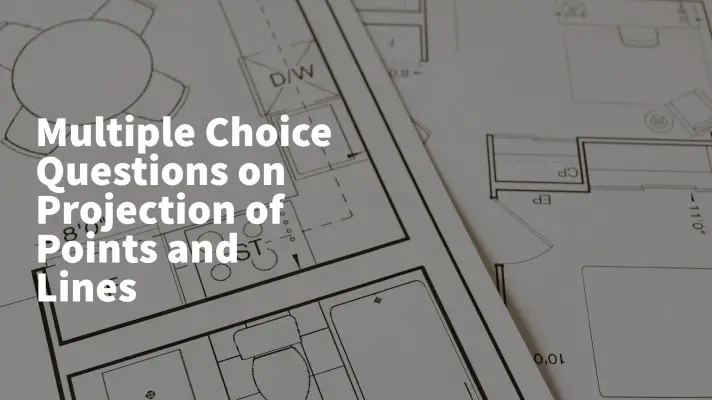Here, I will show you some Multiple-Choice Questions on Projection of Points and Lines in engineering drawings.
At the end of the article, there is a ” PDF downloadable button”. By clicking on that button, you can download the article. I hope that you can enrich your knowledge through the MCQ questions.
Now, let us jump to the MCQ Questions on Projection of Points and Lines.

MCQ Questions or Viva Questions on Projection of Points and Lines
Here is the quiz for you.
Overview
If you want to get the explanations of the answers of the MCQ questions, then please proceed further and read the following text.
I hope that you can clear your doubts by going through the following text.
Methods of projections
In engineering drawing, engineers use the following methods of projections:
- Orthographic projection
- Isometric projection
- Oblique projection
- Perspective projection
What is the Orthographic Projection?
In orthographic projection, engineers represent a 3D object by 2-dimensional multiple views on a drawing sheet. This views are mainly top view, front view, and side view. In this mode of projection, the projectors are parallel to each other and also perpendicular to the plane.
Suppose, there is a book on the table. You are seeing this book from top, from a theoretically infinite distance. The rays of sight from his eyes are parallel to one another and perpendicular to the top surface.
If these rays are extended further to meet perpendicularly on a horizontal plane(H.P), an image is set up below the object. The point at which the lines meet the plane are joined in a proper sequence, then one image is formed. This image is the top view. On the plane, the image is formed, is known as horizontal plane(H.P). The lines are known as projection lines.
What is Isometric projection?
In isometric projection,engineers represent the object by a pictorial view as eyes see it. Here, there is only one view on the drawing sheet.
Types of projections
For representing an orthographic projection, engineers require two numbers planes. These are the reference planes or principal planes of projection. One plane is perpendicular to another.
These are horizontal plane(H.P) and vertical plane(V.P). The intersection line of Vertical plane and Horizontal plane is the reference line.
The projection on the V.P is called the Front view and the projection on the H.P is called the Top view.
When the planes of projection are extended beyond the line of intersection, they create four quadrants. The object may rest in any one of the quadrants.
Here, planes are considered as transparent. We have to draw the perpendicular lines from object to the projection planes to get the projections.
Depending on the position of the object, projections are of four types:
First angle projection
In this case, object rests in the first quadrant i.e. the object is in front of the V.P. and above the H.P.
Suppose, you have kept the book above the table. Now, if you see it from the front, extend the sight rays in the form of parallel lines upto the vertical plane. There will be many intersecting points on the V.P. Join these points sequentially. You will get an image on V.P. This view is front view.
Similarly, when you look at from top, extend the sight rays in the form of parallel lines to meet the horizontal plane. Join the meeting points sequentially and get the image on H.P. This view is top view.
Here, we assume the plane of projection as non-transparent. The “Bureau of Indian Standards’ in 1991 recommends this method of projection.
Second angle projection
In this case, the object rests in the second quadrant i.e. the object is above H.P. and behind V.P.
Third angle projection
In the third angle projection, the object rests in the third quadrant i.e. the object is below H.P. and behind V.P. In this case, we consider the plane of projection as transparent. This method of projection is used in the U.S.A.
Fourth angle projection
In the fourth angle of projection, the object rests in the fourth quadrant i.e. the object is below H.P. and in front of V.P.
In this chapter, a pictorial view of an object, or a point, or a line is given to you. You have to draw the projections of that object.
The multiple-choice questions mentioned here are the basic questions from the chapter Projection of Points and Lines. This will help you in clearing the viva during semester examination. Thank you. Best wishes.


